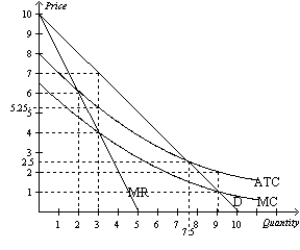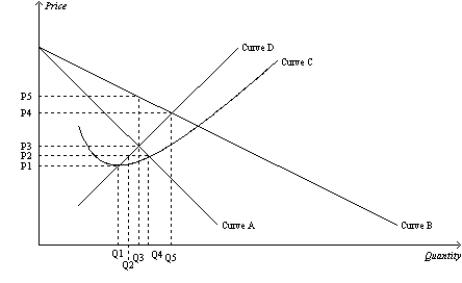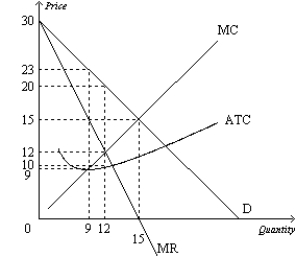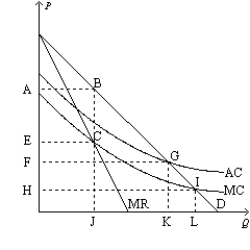A) $0.
B) $1,562.50.
C) $3,125.
D) $6,250.
F) B) and C)
Correct Answer

verified
Correct Answer
verified
Short Answer
Figure 15-2  -Refer to Figure 15-2. What type of monopoly is shown in the figure?
-Refer to Figure 15-2. What type of monopoly is shown in the figure?
Correct Answer

verified
Correct Answer
verified
Multiple Choice
Consider a profit-maximizing monopoly pricing under the following conditions. The profit-maximizing quantity is 40 units, the profit-maximizing price is $160, and the marginal cost of the 40th unit is $120. If the good were produced in a perfectly competitive market, the equilibrium quantity would be 50, and the equilibrium price would be $150. The demand curve and marginal cost curves are linear. What is the value of the deadweight loss created by the monopolist?
A) $40
B) $100
C) $200
D) $400
F) B) and C)
Correct Answer

verified
Correct Answer
verified
True/False
A monopolist's profit is equal to (Price - Marginal Cost) × Quantity.
B) False
Correct Answer

verified
Correct Answer
verified
Multiple Choice
If the government regulates the price that a natural monopolist can charge to be equal to the firm's average total cost, the firm will
A) earn zero profits.
B) earn positive profits, causing other firms to enter the industry.
C) earn negative profits, causing the firm to exit the industry.
D) minimize costs in order to lower the price that it charges.
F) B) and C)
Correct Answer

verified
Correct Answer
verified
Multiple Choice
Figure 15-4  -Refer to Figure 15-4. Profit will be maximized by charging a price equal to
-Refer to Figure 15-4. Profit will be maximized by charging a price equal to
A) P5.
B) P4.
C) P3.
D) P1.
F) All of the above
Correct Answer

verified
Correct Answer
verified
Multiple Choice
Patent and copyright laws encourage
A) creative activity.
B) research and development.
C) competition among firms.
D) Both a and b are correct.
F) None of the above
Correct Answer

verified
Correct Answer
verified
True/False
Average revenue for a monopoly is the total revenue divided by the quantity produced.
B) False
Correct Answer

verified
Correct Answer
verified
Multiple Choice
Which of the following statements is not correct?
A) Part of the deadweight loss associated with monopoly is measured by the monopolist's economic profit.
B) Marginal cost is always less than average total cost in a natural monopoly.
C) Discount coupons available free to the public are a type of price discrimination.
D) Anti-trust laws make it harder for firms to create synergies.
F) A) and C)
Correct Answer

verified
Correct Answer
verified
Multiple Choice
A profit-maximizing monopolist charges a price of $14. The intersection of the marginal revenue curve and the marginal cost curve occurs where output is 15 units and marginal cost is $7. What is the monopolist's profit?
A) $90
B) $105
C) $180
D) Not enough information is given to determine the answer.
F) A) and D)
Correct Answer

verified
Correct Answer
verified
Multiple Choice
A firm cannot price discriminate if
A) it has declining marginal revenue.
B) it operates in a competitive market.
C) buyers only reveal the price they are willing to pay for the product.
D) it has a constant marginal cost.
F) A) and B)
Correct Answer

verified
Correct Answer
verified
Multiple Choice
Scenario 15-5 An airline knows that there are two types of travelers: business travelers and vacationers. For a particular flight, there are 100 business travelers who will pay $600 for a ticket while there are 50 vacationers who will pay $300 for a ticket. There are 150 seats available on the plane. Suppose the cost to the airline of providing the flight is $20,000, which includes the cost of the pilots, flight attendants, fuel, etc. -Refer to Scenario 15-5. How much profit will the airline earn if it sets the price of each ticket at $300?
A) -$15,000
B) -$5,000
C) $25,000
D) $45,000
F) C) and D)
Correct Answer

verified
Correct Answer
verified
True/False
A monopoly creates a deadweight loss to society because it produces less output than the socially efficient level.
B) False
Correct Answer

verified
Correct Answer
verified
Multiple Choice
What happens to the price and quantity sold of a drug when its patent runs out? (i) The price will fall. (ii) The quantity sold will fall. (iii) The marginal cost of producing the drug will rise.
A) (i) only
B) (i) and (ii) only
C) (ii) and (iii) only
D) (i) , (ii) , and (iii)
F) All of the above
Correct Answer

verified
Correct Answer
verified
Multiple Choice
Figure 15-7  -Refer to Figure 15-7. In order to maximize profits, the monopolist should charge a price of
-Refer to Figure 15-7. In order to maximize profits, the monopolist should charge a price of
A) $9.
B) $12.
C) $20.
D) $23.
F) B) and D)
Correct Answer

verified
Correct Answer
verified
Short Answer
Figure 15-4  -Refer to Figure 15-4. If a regulator requires this firm to charge a socially optimal price, how much deadweight loss results?
-Refer to Figure 15-4. If a regulator requires this firm to charge a socially optimal price, how much deadweight loss results?
Correct Answer

verified
Correct Answer
verified
Multiple Choice
A perfectly competitive market
A) may not be in the best interests of society, whereas a monopoly market promotes general economic well-being
B) promotes general economic well-being, whereas a monopoly market may not be in the best interests of society.
C) and a monopoly market are equally likely to promote general economic well-being.
D) is less likely to promote general economic well-being than a monopoly market.
F) B) and C)
Correct Answer

verified
Correct Answer
verified
Multiple Choice
A monopolist's average revenue is always
A) equal to marginal revenue.
B) greater than the price of its product.
C) equal to the price of its product.
D) less than the price of its product.
F) None of the above
Correct Answer

verified
Correct Answer
verified
Multiple Choice
A government-created monopoly arises when
A) government spending in a certain industry gives rise to monopoly power.
B) the government exercises its market control by encouraging competition among sellers.
C) the government gives a firm the exclusive right to sell some good or service.
D) Both a and c are correct.
F) A) and C)
Correct Answer

verified
Correct Answer
verified
Multiple Choice
Scenario 15-4 Suppose a monopolist has a demand curve that can be expressed as P=90-Q. The monopolist's marginal revenue curve can be expressed as MR=90-2Q. The monopolist has constant marginal costs and average total costs of $10. -Refer to Scenario 15-4. The profit-maximizing monopolist will earn profits of
A) $6,400.
B) $3,200.
C) $1,600.
D) $800.
F) C) and D)
Correct Answer

verified
Correct Answer
verified
Showing 521 - 540 of 662
Related Exams